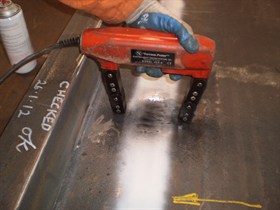Ultrasonic Inspection(UT)
Is a method of detecting sub-surface flaws by directing a
high-frequency sound beam through the material at various angles.
When the sound beam's path strikes an interruption in the material
continuity, some of the sound is reflected back. The sound is
collected by the instrument, amplified and displayed as a vertical
trace on a screen - The response helps to determine location,
size and type of flaw for example, cracks, lack of fusion, slag
inclusions, porosity etc.

Magnetic particle inspection(MPI, MT)
MPI is a non-destructive testing (NDT)
process for detecting surface discontinuities in ferro-magnetic materials.
Finely divided magnetic particles, applied to the magnetized
part, are attracted to and outline the pattern of any
magnetic-leakage fields created by discontinuities.

Dye Penetrant or Liquid Penetrant Inspection (PT, sometimes
referred to as Dye Pen)
Surface flaws that are not visible to the naked eye can be
detected by Dye penetrant inspection. It is widely used for
detection of surface breaking flaws in nonferrous and non-porous
materials such as aluminium and stainless steels.
Penetrating liquid can be either colour contrast (visible) or
fluorescent. The penetrant is applied to the surface of the part to
be examined. Capillary action draws the liquid into the surface
openings, and the excess is then removed. A "developer" is used to
draw the penetrant to the surface, and the resulting indication is
viewed in natural or artificial light or ultraviolet (black) light.
The high contrast makes it possible to detect minute traces of
penetrant that indicate surface discontinuities.
Visual Inspection
A quick and simple method of inspection and compliments all
other disciplines within the field of NDT. The above methods may
need to be utilized to confirm findings.
